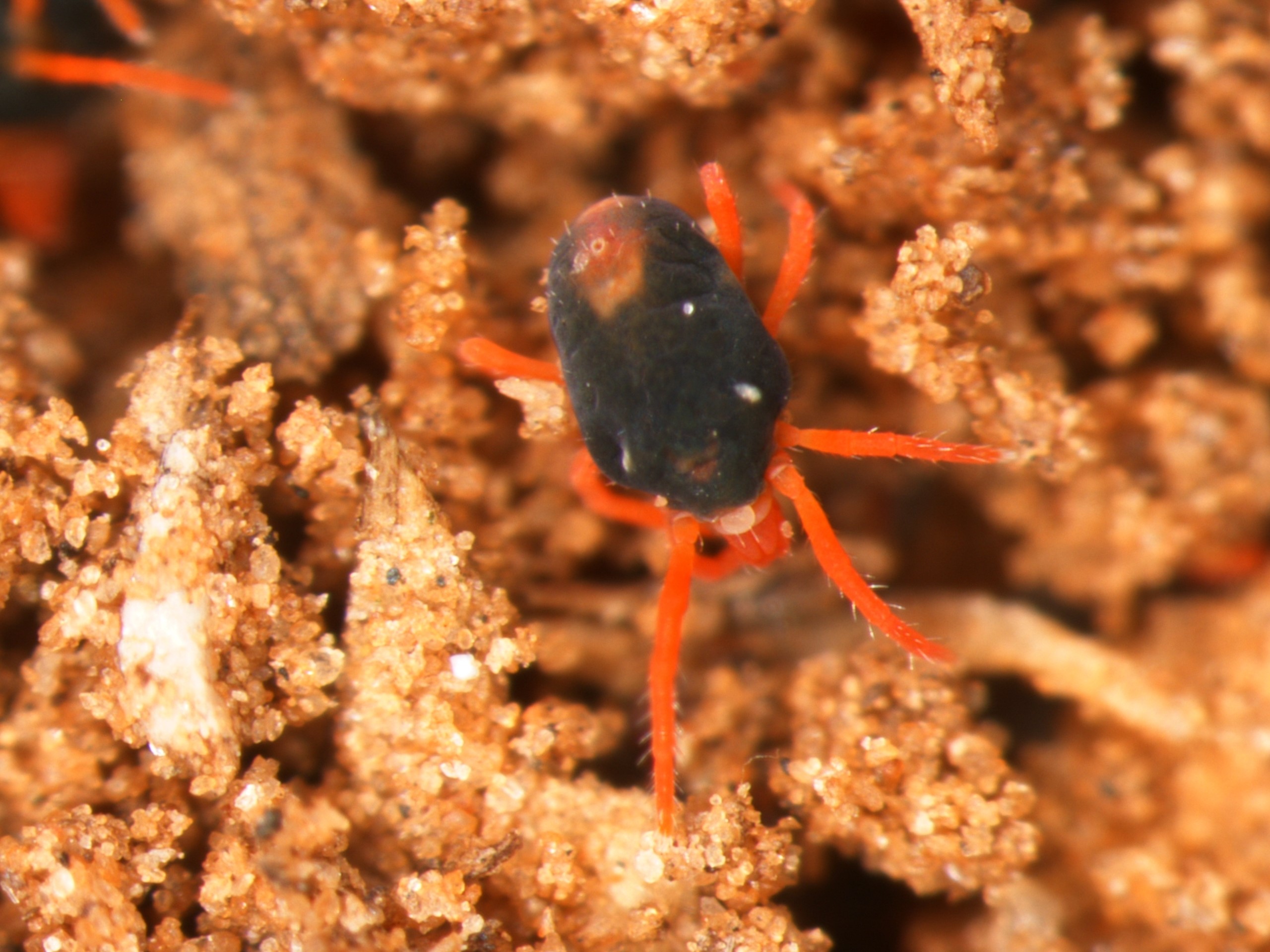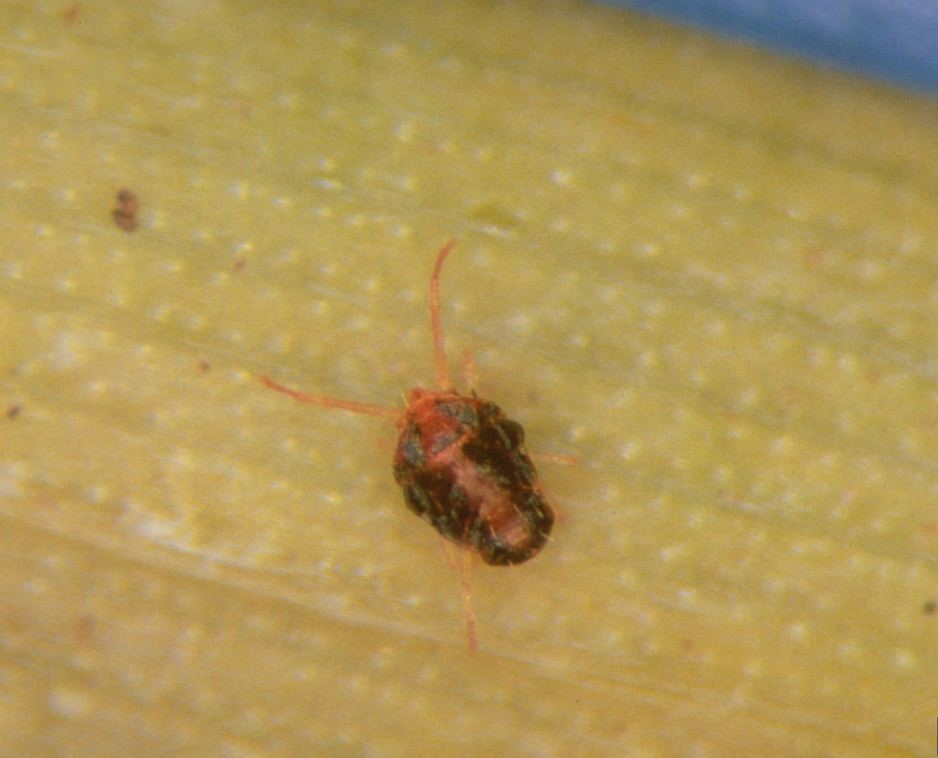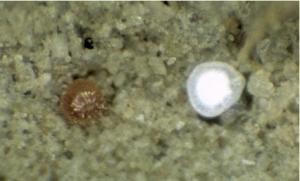Grain Mites in Wheat March 2022
Winter Grain Mite
Description: Winter grain mite is small (about the 1 mm long) with a dark blue to black body and four pair of orange-red legs (Figure 1). It also has a small reddish spot on the top of its abdomen that is visible under magnification. The eggs of WGM are kidney-shaped, and change from clear, to yellow to reddish-orange after several days. They are laid on leaf blades and stems or the roots near the crown. Besides wheat, many grasses serve as host plants, including barley, oats, ryegrass and fescue.
Life Cycle: Winter grain mites complete two generations per year, the first beginning in fall from over-summering eggs and the second from eggs laid in January/February. Winter grain mites over-summer as eggs. In all cases, adult mites are females, all of which are capable of laying eggs. The first generation peaked in December/January and the second will peak in March/April. Newly- hatched mites molt three times before becoming adults, and take up to 60 days to mature. Adults can live for up to 40 days. They get their name because they prefer grains and grasses, and they really don’t like warm weather. They are most active when temperatures are between 40O and 70O F. Freezing conditions and/or snow cover do not really affect them.
Figure 1. Winter grain mite and over-summering egg (Photos by Richard Grantham, Oklahoma State University.)
Nature of Damage and Scouting: Winter grain mites feed by piercing plant cells in the leaf, which results in “stippling”. As injury continues, the leaves take on a characteristic grayish or silverish cast, which could be mistaken for injury due to herbicide. Winter grain mites are more likely to cause injury in wheat if the crop is stressed due to lack of moisture or nutrients. Winter grain mites are light sensitive and tend to avoid bright, sunny days and windy days, so adjust your scouting accordingly. On still, cloudy days or early morning/evening, they will be active on the plants and can easily be counted. They reside under the soil surface (up to a couple of inches) or massed under dirt clods on sunny or windy days.
Control Decisions: Winter grain mites are more common in fields of continuous wheat. Crop rotation, especially with a winter crop such as canola, will help break their cycle. They tend to be more numerous in fields that receive a minimum amount of tillage. Winter grain mites do not typically cause severe injury unless present in excessive numbers and plant growing conditions do not sustain rapid growth of wheat foliage, such as when an infestation is coupled with nitrogen or water deficiency. While WGM pests can damage wheat even under normal growing conditions, it takes large numbers to justify an insecticide application for their control. There is no established threshold for WGM; my best “guestimation” is to treat when injury symptoms are visible and mite numbers exceed 10 per plant
Brown Wheat Mite
Description: Brown wheat mite is small (about the 0.5 mm long) with a dark brown body and four pair of light brown to yellow legs. The forelegs are twice as long as the three remaining pair of legs (Figure 2). The eggs of BWM are round, red and hatch in about 7 days. Their over-summering eggs are white and diapause through the summer, hatching again the following fall.
Life Cycle: Brown wheat mites complete several generations per year, the first beginning in fall from over-summering eggs. Newly hatched mites molt three times before becoming adults and can complete their lifecycle in about 21 days at 71O F. They are more prevalent during dry weather, so injury can be confused with drought stress.
Figure 2. Brown wheat mite adult eggs: regular (red) and over-summering (white). Photos by Frank Peairs, Colorado State University.
Nature of Damage and Scouting: Brown wheat mites feed by piercing plant cells in the leaf, which results in “stippling”. As injury continues, the leaves take on a “bronze” color or scorched appearance that could be mistaken for injury due to drought stress or herbicide. Brown wheat mites are more likely to cause injury in wheat if the crop is stressed due to lack of moisture or nutrients. This mite is more active in the afternoon, especially on warm days. An easy way to inspect for brown wheat mite is to shake some
plants onto a white piece of paper, making the mites easy to observe.
Control Decisions: Brown wheat mites are more common in fields of continuous wheat, so crop rotation, especially with a winter crop such as canola, will help break their cycle. Rainfall of greater than 0.25 inches will often reduce BWM build up as well. Research suggests a treatment threshold of 25 to 50 BWM per leaf in wheat that is 6-9 inches tall. An alternative estimation is “several hundred” per foot of row.
Insecticides: If an outbreak requires application of an insecticide, the only one registered for control of BWM in wheat is dimethoate, and I am aware of none that list WGM on their label. However, under section 2(ee) regulations of the Federal Insecticide, Fungicide and Rodenticide Act (FIFRA), a product that is labeled for use in a crop can be used to control a pest that is not specifically on the label. Keep in mind that the application rate used must fall within the range of labeled rates for that crop AND if the pest is not on the label, the user assumes all responsibility for the effectiveness of the application.
Remember, as of March 1, 2022, it is not legal to apply chlorpyrifos, (Lorsban and generics) in wheat or any other formerly labeled crop because the tolerance (for residues) was rescinded.
Any insecticide used to control WGM or BWM will likely be less effective when plants are drought stressed. More detailed information on these two mites along with the wheat curl mite are described in EPP-7093 “Mites in Small Grains”, and control suggestions are listed in CR-7194, “Management of Insect and Mite Pests in Small Grains” which includes registered insecticides, application rates, and grazing/harvest waiting periods.




